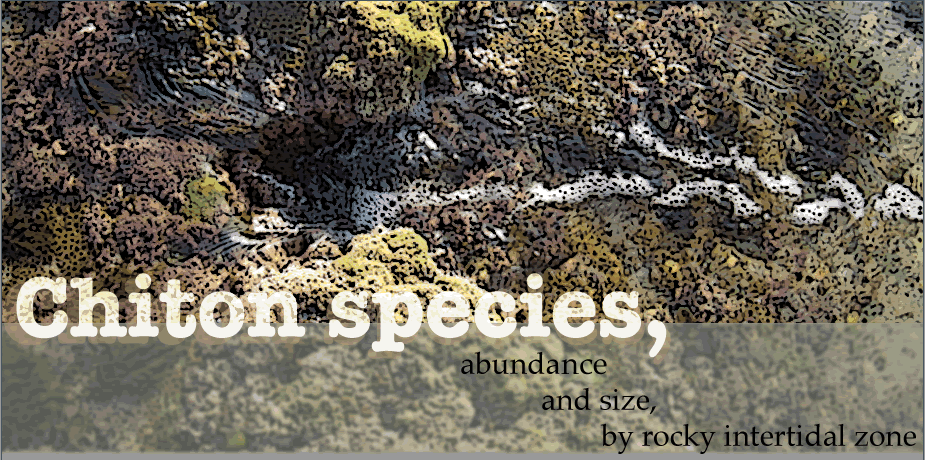 |
||||||||
 |
||||||||
| The spatial distribution of different species across the intertidal zone is dependent upon the environment they prefer. Additionally, in their specific environment there is a preference of what they like in their surroundings and where they like to reside in it. Chiton, a species that is found within the phylum Mollusca, are primarily found in the moist region between the rock and sand, but not completely immersed in water. Being able to understand the spatial distribution of chiton across the intertidal zone is important in order to see what type of environment they prefer to live in and essentially to understand the ecology of chiton. Previous research has been done on chiton distribution among a certain area; one such study was conducted in the sub-Antarctic regions. The outcome of this study suggested that the distribution of chiton was dependent upon the salinity of the water as well as the temperature and biotic factors (Simpson, 1976). Areas with more salinity possessed more chiton population. Another study, conducted in the intertidal zone of Guanacaste in Costa Rica, focused on the vertical distribution and species composition in the tide pools of this Costa Rican shore. They examined the difference in salinity, temperature range and periods of emersion to see the influence it had on their distribution among the zones. One main finding was that "two of the nine species (Chiton stokesii and Acanthochitona hirundiniformis) occurred mainly on rocky areas outside the tide pools with variable amounts of exposure to air during each tidal cycle. In both species the tide pool specimens were significantly smaller than those collected in the rocky areas. Distribution of all other species was restricted to the tide pools and species had their peak abundance in the zones with more moderate conditions and a higher diversity of algae, resulting in the highest chiton diversity in these areas" (Jorger, 2007). In this study we see that not only did the wave action, temperature, and salinity of the water have an effect on the distribution of chiton but the abundance of other species in the area had an effect as well. There was a correlation between the amount of life found underneath the surface of the rock and whether chiton would be found in that habitat. In 1998, a study was done near the rocky shores of Sydney, Australia which demonstrated that chiton were most abundant in the mid than in low shore areas. This was done by selecting a section of the shore in which all zones were moderately exposed. "On each shore, two sites separated by 50-70m were randomly selected in low- and mid-shore areas at approximately mean low water of neap tides and at mid-tide levels, respectively. In each site, five randomly placed replicate cores of coralline turf were collected using a sharpened metal corer, which had an internal diameter of 80mm (0.005m2). Only areas with 100% primary cover of algae, of which at least 95% was Corallina officinalis, were sampled. For each replicate, the algae and sediment inside the corer were scraped off at the level of the rock and preserved in 7% formalin solution. All replicates were washed in a 500-mm sieve. Any A. retrojecta that were retained were identified and counted under 12 magnification" (Cole, 2004 ). With this research we can see again that the environment and zone had an effect on the abundance of chiton in the mid- shore area. In the rocky intertidal zone of Station Beach of Puerto Penasco, we noticed that there were two rocks that were primarily seen throughout the zones: coquina and basalt. Our research was conducted around the hypothesis that chiton prefer to attach themselves to, the coquina or basalt and which species of chiton preferred the rock. The species of chiton that we dealt with were: green striped chiton (Chiton virgulatus), brown chiton (Chiton articulatus), black chiton (Chiton stokesii) and striped or heath's chiton (Stenoplax heathiana). We also tested to see what intertidal zone chiton seem to be most prevalent in as well as if there was any connection with the size of the rock and the size of the chiton. This spatial distribution of chiton is essential to see where they are more likely to form their assemblages in and analyze the area they preferred in order to see if there are any other effects or reasons as to why they choose a certain environment besides zone and rock preference. Works Cited   |
||||||||